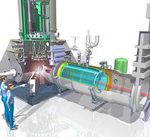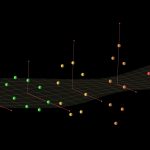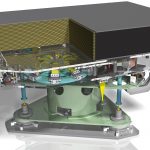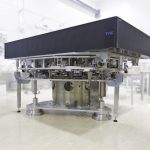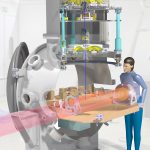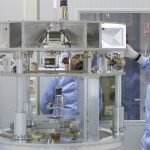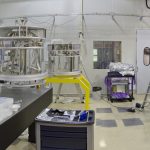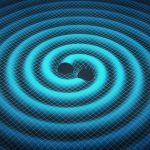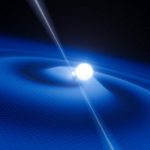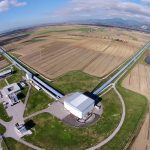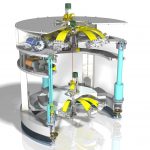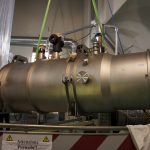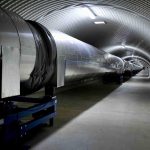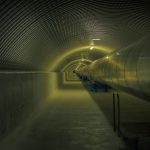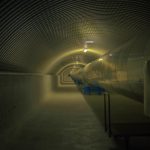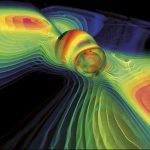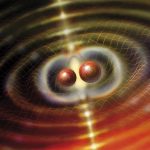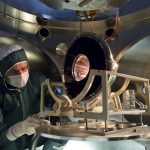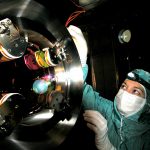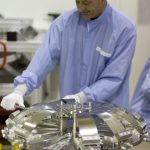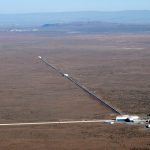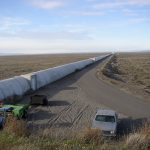De hoge-resolutieversies kunnen hier worden gedownload.
De foto’s mogen gebruikt worden zolang de volledige bijschriften met credits gebruikt worden.
1. Artist’s impression of a cryolink that is installed in between the main beampipe and the towers containing the end mirrors in the 3-km long interferometer arms; the cryolinks are an essential ingredient in reaching the ultrahigh vacuum requirements of Virgo. Credit: Marco Kraan, Nikhef
2. Illustration of the (largely exaggerated) effect of a gravitational wave passing by five groups of test-masses. The masses do not interact between them. They are initially located along parallel circels centered around the same axis. The circles are separated by a quarter of the gravitational wave wavelength. The grid plane and the axis help the eye to visualise the modification of the distances between the test-masses. Credit: Virgo Collaboration/LAPP/D.Busculic
3. Artist impression of the suspension system that isolates the external injection optical bench from seismic noise. Credit: Marco Kraan, Nikhef
4. The suspension system that isolates the external injection optical bench from seismic noise. Credit: Marco Kraan, Nikhef
5. Artist impression of the in-vacuum seismic attenuation system that suspends the injection and detection benches. Credit: Marco Kraan, Nikhef
6. Assembly and testing of the multi-stage seismic attenuation systems in the clean room at Nikhef. Credit: Marco Kraan, Nikhef
7. Panorama of the clean room at Nikhef. Credit: Marco Kraan, Nikhef
8. Spacetime is perturbed by the motion of two black holes rotating around each other. Credit: Swinburne Astronomy Productions
9. Artist’s impression of an exotic double object, consisting of a tiny, but very heavy neutron star (pulsar PSR J0348+-342) spinning 25 times per second, orbited every two and a half hours by a white dwarf star. Credit: ESO/L. Calçada
10. Virgo aerial view, looking west. Both arms are 3 km in length. The 144 m long tube for the Input Mode Cleaner cavity is seen along the west arm. Credit: ESO/L. Calçada
11. Artist’s impression of the Input Mode Cleaner. Credit: Marco Kraan, Nikhef
12. Artist impression of the suspension of the secondary optical benches that are seismically isolated. Credit: Marco Kraan, Nikhef
13. Installation of the cryolink. Credit: Marco Kraan, Nikhef
14. The Virgo north pipe. Credit: Kees Huyser, Nikhef
15. The Virgo north vacuum tube, 1.2 m in diameter inside its 3 km long tunnel. Credit: Virgo Collaboration
16. The Virgo west vacuum tube, 1.2 m in diameter inside its 3 km long tunnel. Credit: Kees Huyser, Nikhef
17. The Virgo north vacuum tube, 1.2 m in diameter inside its 3 km long tunnel. Credit: Kees Huyser, Nikhef
18. Modelling gravitational wave complexity. Credit: MPI for Gravitational Physics/W.Benger-ZIBFig 18
19. Artist’s impression of gravitional waves produced by two neutron stars. Credit: INFN
20. Installation of the Input Mode Cleaner Credit: Marco Kraan, Nikhef
21. Repositioning an actuator in the Input Mode Cleaner. Credit: Virgo Collaboration
22. Technician working on the Seismic Attenuation System. Credit: Marco Kraan, Nikhef
23. The LIGO observatory at Hanford, Washington. Credit: LIGO Hanford Observatory
24. The LIGO north pipe at Hanford, Washington. Credit: Wikipedia
